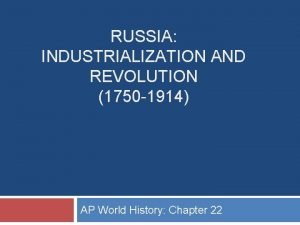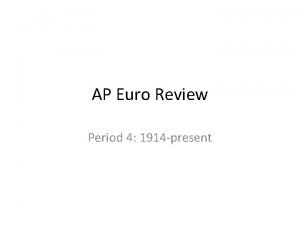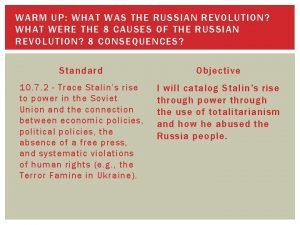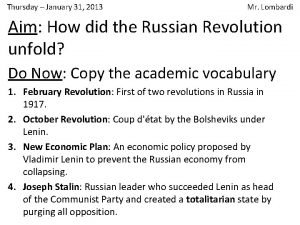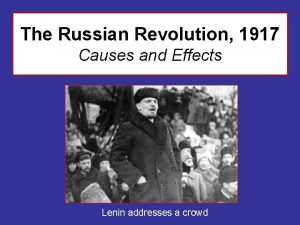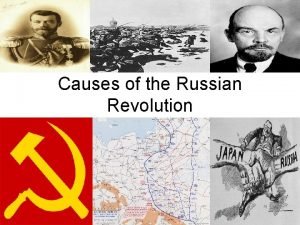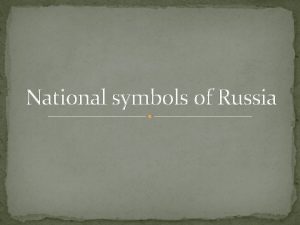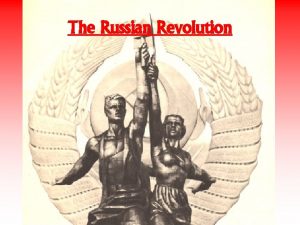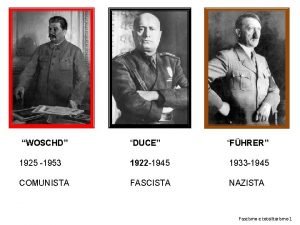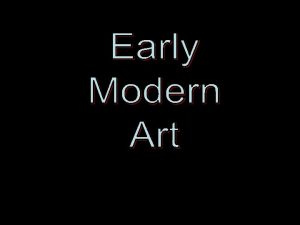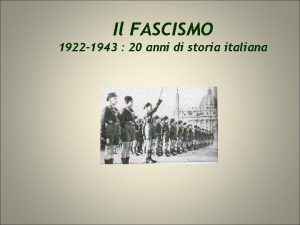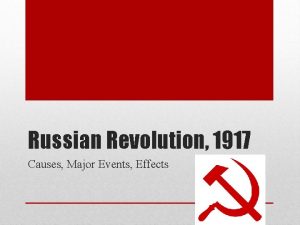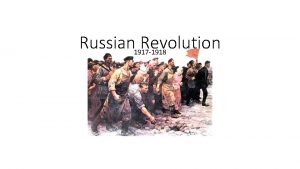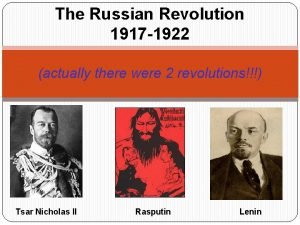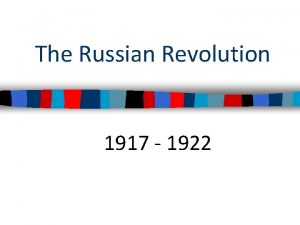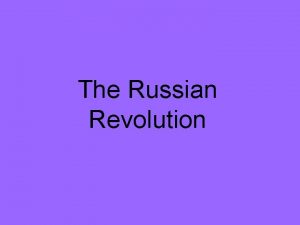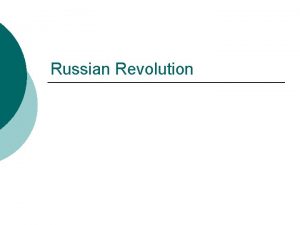RUSSIAN REVOLUTION 1917 1922 9 Causes of Russian













- Slides: 13

RUSSIAN REVOLUTION 1917 – 1922

9 Causes of Russian Revolution 1. 2. CZARIST RULE: autocratic rulers who have total power, very little rights for the people PEASANT UNREST: peasants were extremely poor and lacking proper nutrition, wanted more rights References Citation (MLA) The Russian Revolution. Classroom Media. 1998. Power. Media. Plus. com. 17 January 2008. <http: //www. powermediaplus. com>

3. PROBLEMS OF URBAN WORKERS: peasants working in factories worked long hours for low pay 4. DIVERSITY & NATIONALISM: ethnic minorities did not want cultures destroyed through Russification

5. BLOODY SUNDAY: Czar Nicholas II orders soldiers to fire on peaceful protestors and small revolts occur as a result References Citation (MLA) The Russian Revolution. Classroom Media. 1998. Power. Media. Plus. com. 17 January 2008. <http: //www. powermediaplus. com>

6. WORLD WAR I: Russian soldiers lacked adequate weapons/supplies and were losing the war The Russian Revolution. CLEARVUE & SVE (1989). Retrieved January 17, 2008, from Power. Media. Plus. com: http: //www. powermediaplus. com

7. MARCH REVOLUTION: workers began strikes and riots against the government forcing the czar to abdicate (give up ruling power) 8. FAILURE OF THE PROVISIONAL GOV’T: continues fighting in WWI and does not end the unrest among peasant workers, who demanded land The Russian Revolution. CLEARVUE & SVE (1989). Retrieved January 17, 2008, from Power. Media. Plus. com: http: //www. powermediaplus. com

9. BOLSHEVIK REVOLUTION: Soviets (local councils of workers, peasants, soldiers) are set up in cities to take over gov’t & guide the revolution, came to power with the promise of “Peace, Bread, Land” The Russian Revolution. CLEARVUE & SVE (1989). Retrieved January 17, 2008, from Power. Media. Plus. com: http: //www. powermediaplus. com

RUSSIA UNDER LENIN • Lenin pulls Russia out of World War I by making a deal with Germany and giving them a large amount of land • Russian Civil War (1918 – 1921). Lenin’s Red Army led by Leon Trotsky battled against different rival groups. Lenin’s forces win in 1921 The Russian Revolution. CLEARVUE & SVE (1989). Retrieved January 17, 2008, from Power. Media. Plus. com: http: //www. powermediaplus. com

• Communist Party (classless society ruled by workers) ruled Russia and enforced its will through the military and secret police • New Economic Policy (NEP) Government controlled banks, large industry and foreign trade. • Russia renamed the Union of Soviet Socialist Republics The Russian Revolution. CLEARVUE & SVE (1989). Retrieved January 17, 2008, from Power. Media. Plus. com: http: //www. powermediaplus. com

U. S. S. R. UNDER STALIN • Totalitarianism: a government that has total power to completely control every part of the lives of its people. Soviet Union became a totalitarian state

• Stalin increases the size and power of the secret police. The Great Purge begins, movement which eliminates anyone who threatens Stalin’s power

• Executions, imprisonment or exile were punishments if found guilty in Stalin’s court. • Millions of people died as a result of Stalin’s punishments • Five – Year Plans: goal to increase output of steel, coal, oil & electricity at the expense of consumer goods, creating food, clothing & housing shortages.

• Collective Farms: large farms owned by the state and operated by peasants as a group. Many peasants resisted government attempts to seize land. • 5 to 10 million peasants died as a direct result of Stalin’s agricultural revolution
 Russian revolution of 1905 definition ap world history
Russian revolution of 1905 definition ap world history Triple alliance ap euro
Triple alliance ap euro Russian revolution causes and effects
Russian revolution causes and effects Causes of the russian revolution
Causes of the russian revolution Causes and effects of the russian revolution
Causes and effects of the russian revolution Effect of russian revolution
Effect of russian revolution Russian revolution vs french revolution
Russian revolution vs french revolution Russian national symbols
Russian national symbols March 1917 revolution
March 1917 revolution 1953-1922
1953-1922 Paul klee senecio 1922
Paul klee senecio 1922 Kirjandusrühmitus tarapita
Kirjandusrühmitus tarapita El fascismo italiano
El fascismo italiano Facts about christiaan barnard
Facts about christiaan barnard
